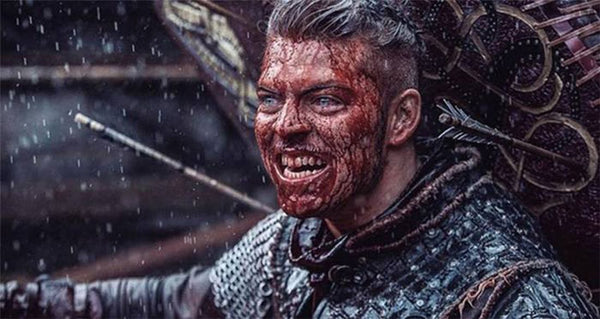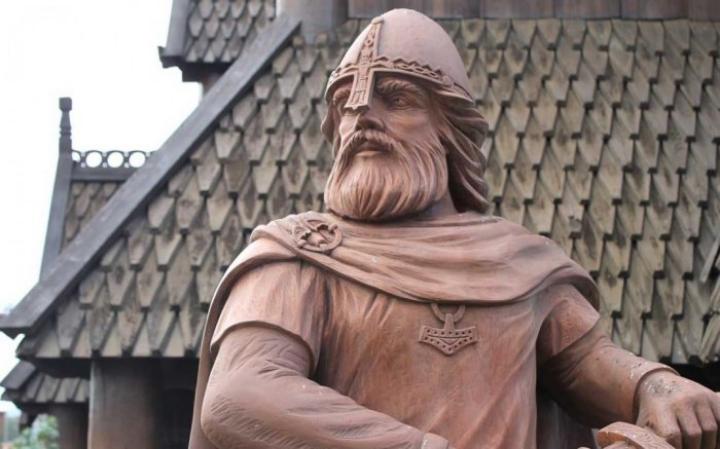Thanks to the TV series Vikings, very few people fail to recognize the name Ivar. The real Ivar, however, may be very different than the one from the TV.

According to the Volsunga Saga, the proud Viking is also known as Ivar Ragnarsson, being the son of the couple blessed by Frigg Ragnar Lothbrok and his wife Aslaug. He is described as “Only cartilage was where bone should have been, but otherwise, he grew tall and handsome and in wisdom, he was the best of their children.” Emphasis on “tall”.

Jóhann Kristinn Pétursson (1913–1984), also known as the Icelandic Giant and the Viking Giant
Considering that having no bones would make it pretty difficult to stay alive, it’s obvious that to call Ivar “Boneless” is a bit exaggerated. Having said that, modern historians have some interesting theories as to why he acquired the infamous nickname.
There are two prevalent theories as to why Ivar gained the moniker “Boneless”. The first one suggests that he may had a condition called osteogenesis imperfecta, which leaves sufferers with fragile, glass-like bones. The second theory takes into account descriptions of him given by the sagas and archaeological finds from the XVII century.
According to the Ragnar Saga, Ivar was massive and ferocious in battle. The saga emphasizes his extreme upper-body strength, suggesting an almost superhuman might.

Ivar the Boneless’s parents, Ragnar Lothbrok and Aslaug.
According to the saga, during a battle against King Eysteinn of Sweden, Ivarr is said to have secured victory by defeating a bewitched cow named Sibilja. It is said that, during the battle he orders his men to carry him towards the terrible beast. He then draws a longbow “as large as a tree trunk”, drawing it back “as if it were only a weak elm twig”. Ivar shoots two arrows from the bow, blinding the crazed bovine and claiming victory.
The typical length of an ordinary longbow is around two meters, making firing an arrow with it, while seated, a near impossible feat, which attests Ivar's considerable might, worthy of Thor himself.
Also, in a time where warriors had to run to face their enemies in battle, it would be very unlikely that Ivar acquired the reputation of great warrior without at least being able to stand. Tales of Ivar’s strength are legendary, suggesting that when the sagas described him as “tall” and “strong”, it was not poetic license.
In 1686 an excavation at the churchyard of St Wystan’s Repton, Derbyshire, found “a humane body nine foot long” (2,74m) surrounded by further skeletons, like Odin the God of War circled by his entourage. Professor Martin Biddle of Oxford University and his wife Birthe Kjølbye-Biddle claim that those remains belonged to Ivar the “Boneless”, making a compelling case about it. There are, of course, no definitive proof that those bones belonged to Ivar, but if the actually did, that means he would’ve been taller than Robert Wadlow, the tallest man recorded in history, who notoriously needed leg braces to stand. This need of leg bracers to stand would fit nicely with the saga's description of him using a “longbow as large as a tree trunk” and being fierce in battle. This could easily justify his difficulty in walking while still being considered a tall and mighty warrior, as fierce as Fenrir.

Five months before his death, the World’s Tallest Man, Robert Wadlow, demonstrates his sheer size by towering over a hotel lobby clock on February 23, 1940, in St. Petersburg, Florida
In 2018, another excavation at St. Wystan's Church found the remains of around 300 people, with evidence suggesting they belonged to Vikings from the “Great Heathen Army”, led by Ivar himself.

The site is believed to have been a winter camp for the Viking army
According to Cat Jarman, study author and Ph.D. student in the University of Bristol's Department of Archaeology and Anthropology:
"It seems likely that the Great Army attacked the Anglo-Saxon monastery and used the site as a winter camp.” … “At some point, possibly towards the end of the winter before the army moved on…”
This finding, on the very same place where three hundred years earlier was found a “nine feet long skeleton,” greatly favors the theory of Ivar’s great height.
Ivar's true life was quite different than what depicted on the TV series. For one thing, the true Ivar was a man of honor, deeply dedicated to his family and they, in turn, respected him. In fact, when their father Ragnar Lodbrok died, tossed into a snake pit, Ivar’s brothers turned to him to lead the way.
When the news of his father’s death by the king Ælla of Northumbria reached his sons, Ivar decided to form what the English would dub the “Great Heathen Army” and go to war with Northumbria. Ivar was the general and mastermind behind the army’s tactics, no other.
While Ivar Ragnarsson might had difficulties to walk, according to stories from Vikings fighting beside him, he would still fight in the vanguard of the army.
When Ivar conquered the Northumbria, one of his first orders of business was to “Blood Eagle” king Ælla. The gruesome execution took place as Ælla’s ribcage was ripped open from behind and his lungs were pulled out into the shape of wings. Then, to make it as painful as possible, they sprinkled salt into his bloody wounds.

Ælla’s death was just the beginning of Ivar’s expedition to England. His next target was Mercia, at the time, the greatest kingdom of the British Isles.
The Great Heathen Army set up a base near the Mercian city of Nottingham and spent more than a year attacking and withdrawing from it, before managing to break through its walls. With Mercia falling under their rule, the rest of England could barely stand against the might of the Viking army. The Eye of Odin watched closely over his chosen ones.
Ivar and his army were (in)famous for their "creative" executions, which doubtlessly played a significant role in diminishing the opposition faced by the Vikings. One of the most gruesome tales describe to us how King Edmund of East Anglia was executed. Ivar had him brutally beaten with clubs, bound up in iron chains, tied to a tree, and filled full of arrows until he looked like a porcupine. Only then did he allow him to die; Edmund’s head was chopped off and thrown into the brambles. The king went through such an ordeal that the christians at the time sainted him “Edmund the Martyr.”

Martyrdom of St. Edmund, by Brian Whelan
By 870 AD, Ivar Ragnarsson’s dominion over Britain stretched all the way to Dublin. But then, seemingly out of nowhere in 873, he died. The only information we have comes from a book called the Annals of Ireland:
“The Norwegian king…died of a sudden hideous disease. Thus it pleased God.”
As expected, the Church and christians kings were pretty happy about his passing.
Legend has it Ivar asked to be buried in a place that was exposed to attack. As long as his body was buried there, he promised his loyal men, no one would be able to defeat them.
Evidence suggests that during the (very brief) times of peace, Ivar may have been a good ruler, demonstrating generosity to his subjects as well as religious and ethnic tolerance. Though he is commonly characterized by villainy and treachery by christian monks (who actually wrote the history books back then), he is nonetheless admirable, as his wyrd was to become one of the greatest Viking rulers of all time. And while Ivar’s lifetime was full of war, he helped build a kingdom that would allow his people to settle down and trade, helping the Vikings become some of the most successful merchants of their time.
For now, there is no definitive proof of how exactly Ivar looked like, but regardless of his appearance, he was indeed a true giant amongst Vikings.

Steine of Long Stone (or Ivar the Boneless' Pillar). It is a replica of a carved pillar, erected by the Vikings in the 10th or 11th century. Located in Dublin, at the junction of Pearse Street and College Street
Sources:
Simek, Rudolf. 1993. Dictionary of Northern Mythology. Translated by Angela Hall. ISBN-10 0859915131
Jesse Byock (2005) Snorri Sturluson, The Prose Edda. 1st. edition. London, England: Penguin Books Ltd. ISBN-13 978-0-140-44755-2
Cantor, N. F. The Civilization of the Middle Ages. Harper Perennial, 1994.
Ferguson, R. The Vikings: A History. Viking Books, 2010.












